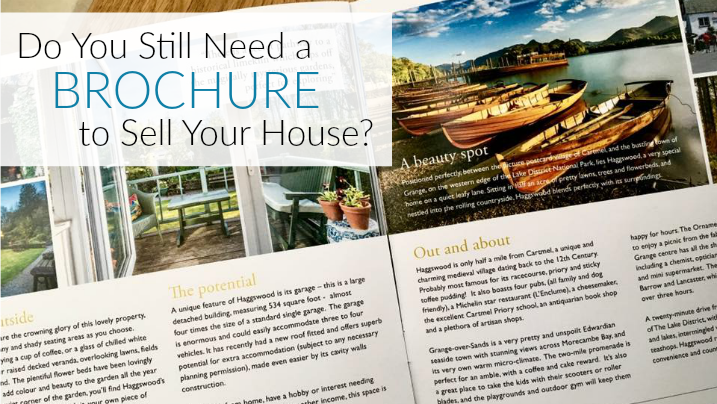
Way back in the olden days, my mum worked in an estate agency. I remember her sticking little photographs onto typed particulars with glue.
How times have changed. I’ve been collecting the very best property brochures for around fifteen years now and there isn’t a stuck-on photograph in sight.
If your home is on the market, what does your brochure look like?
If your agent is doing a good marketing job, you should have had created for you a beautiful brochure of anything from 4 – 12 pages long, laminated or extra thick card, packed with professional and beautiful images, skillfully-drawn floorplans and a written description full of emotion so that it really brings your home to life.
This is not a set of ‘particulars’. On the contrary – it is a brochure. Synonymous in quality and content with the best hotel brochures, and those of travel companies, luxury gyms, status watches and top marque cars. After all, your house is worth many times more than almost any of those purchases.
The best brochure doesn’t just sell bricks and mortar, it showcases a lifestyle. The more attractive and aspirational is is the better it does its intended job – to encourage buyers to show it to their friends and family, to motivate them to look at it over and over, and for them to really enjoy the experience of doing so.
Sometimes I look at a client’s property brochure in despair.
Their home could be a beautiful, unique house full of character, and for reasons only known to the estate agent in question, they are attempting to market it with a flimsy A3 folded sheet, printed from the office printer. The text is lacking in any kind of warmth; the photographs are dull and dark, having been printed straight onto copier paper, and the overall result is cheap and amateurish. This lack of care and attention to the marketing of a house can permeate a buyer’s view of the property; after all, if the estate agent and seller don’t care enough about it to take the time it needs in creating a beautiful showpiece for the house, how can we expect the buyer to see it as their dream home?
Of course, if you are selling a studio flat in a less than salubrious area, you might expect the property details to consist of only a single sheet of A4 with perhaps a couple of paragraphs and three or four photographs, but if your house is a good sized family home, it will usually warrant considerably more effort. if you have a house packed with interesting and unusual features, a pretty garden, or both, then your brochure really needs to reflect this and make sure a buyer’s attention is captured long enough for them to book a viewing to see it for themselves.
It’s a common objection that too good a brochure can ‘oversell’ a house. It’s true that if you set a buyer’s expectations low, they are more likely to be bowled over when they actually visit the house. But this is a pretty risky strategy: if your brochure undersells your home, there’s a strong likelihood that no one will book a viewing anyway. With every buyer viewing on average 12-15 properties before making an offer on one, yours must really stand out to be in with a chance of being remembered. Make sure your brochure size, type and style all reflect your home and that you are proud to call it your showcase: after all, your brochure really is the gateway between you and your future buyer, so make sure you keep that gate firmly open.
Unique homes need unique brochures.
If you’re lucky enough to have a unique home, you’ll know that it’s difficult for someone to appreciate its characteristics and appeal without visiting it in person. But to get a buyer to book a viewing, they need to be intrigued, attracted and compelled by your home. And the best way to do this, is via a brochure that is commensurate with the value and calibre of the home it portrays.
Although almost every property search begins online, on screen, houses can appear unloved, surreal, unattainable, cold: in short – unhomely. Yet, a lovingly created brochure in my hands, with its warm, inspiring photography and hand-crafted description can really bring a house to life. There is something very satisfying about actually holding a physical brochure, instead of just gazing at the information on a phone or laptop. And as a result, we believe that beautiful printed brochures result in more and better quality viewings.
Last week, I had cause to call an estate agent in Essex to ask him to send me a client’s property brochure. “Sorry madam we don’t send out hard copies,” he responded. “This is the 21st Century after all,” he pointed out.
“But I don’t have a printer,” I pleaded (a little white lie, I admit).
“Okay,” he relinquished “just this once”. True to his word as a massive favour to whom he thought was a prospective buyer, he printed a copy off the internet and actually posted it to me.
Since when was it considered to be a “favour” to send a brochure to a interested buyer? When did printed property details become “hard copy” and as such, an outdated form of marketing properties?
If you are trying to sell your house, and viewers are not exactly beating a path to your door try this little exercise: call your agent, posing as a buyer, and ask for your own property brochure to be sent to you. See what happens, but I warn you, you may find the response disappointing.
I’d be interested to hear our Essex agent explain to Mercedes, Argos or Next that physical paper marketing does not work. They may disagree with him. I certainly do.
Maybe I’m just a little bit old-fashioned. But, then, there are a lot of us around, and some of us buy houses.
Please drop us a line by clicking here or call us on 015394 88811 – we’d love to hear from you.
Sam and Phil

